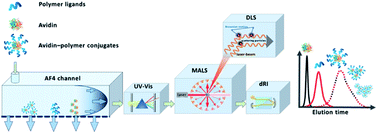A comprehensive analysis in one run – in-depth conformation studies of protein–polymer chimeras by asymmetrical flow field-flow fractionation †
Abstract
Polymer-based protein engineering has enabled the synthesis of a variety of protein–polymer conjugates that are widely applicable in therapeutic, diagnostic and biotechnological industries. Accurate characterizations of physical–chemical properties, in particular, molar masses, sizes, composition and their dispersities are critical parameters that determine the functionality and conformation of protein–polymer conjugates and are important for creating reproducible manufacturing processes. Most of the current characterization techniques suffer from fundamental limitations and do not provide an accurate understanding of a sample's true nature. In this paper, we demonstrate the advantage of asymmetrical flow field-flow fractionation (AF4) coupled with multiple detectors for the characterization of a library of complex, zwitterionic and neutral protein–polymer conjugates. This method allows for determination of intrinsic physical properties of protein–polymer chimeras from a single, rapid measurement.



 Please wait while we load your content...
Please wait while we load your content...